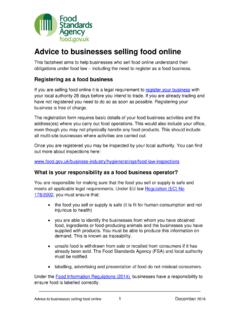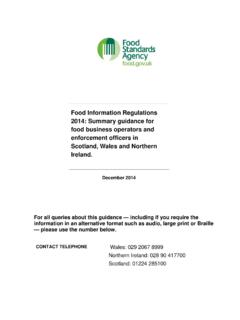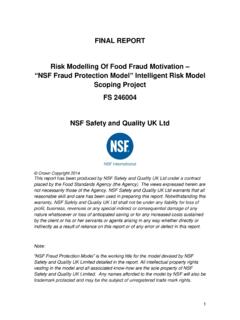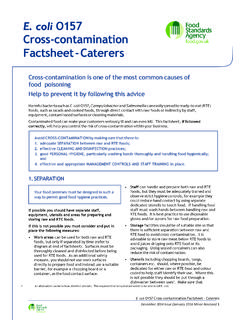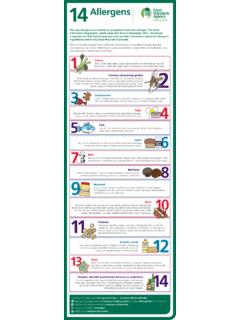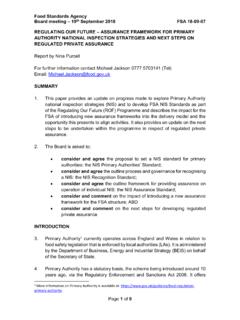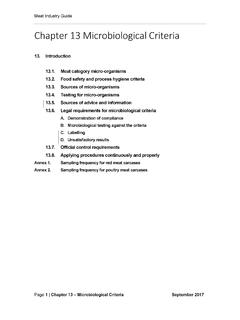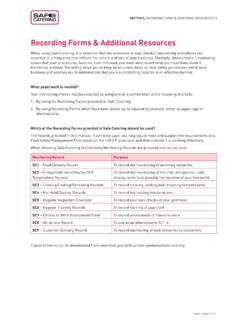Transcription of Guidance Notes for Food Business Operators on Food Safety ...
1 July 2007 Guidance Notes for food Business Operators on food Safety , traceability , product withdrawal and recall A guide to compliance with Articles 14, 16, 18 and 19 of General food Law Regulation (EC) 178/2002 July 2007 2 CONTENTS Page Number Introduction 3 Summary for Small Businesses 5 Overview 6 Article 14 ( food Safety requirements) 7 Article 16 (Presentation) 10 Article 18 ( traceability ) 11 Article 19 ( withdrawal , recall and notification) 13 Enforcement 16 Annex 1 Definitions 17 Annex 2 Legislation relevant to Regulation (EC) 178/2002 19 Annex 3 EC Guidance on Articles 11, 12 and 17 21 Annex 4 Contact details for further queries on FSA Guidance Notes 26 July 2007 3 Introduction 1.
2 These Guidance Notes have been produced with the aim of providing informal, non-statutory advice on compliance with the requirements for food businesses of Articles 14, 16, 18 and 19 of Regulation (EC) 178/2002. food businesses are required to comply with this legislation which relates to the Safety of food , traceability , notification of food Safety incidents and withdrawal and recall of unsafe food . The Guidance Notes should be read in conjunction with the food Safety Act 1990 (Amendment) Regulations 2004 (No. 2990) and the General food Regulations 2004 (No. 3279)1 (see Annex 2). The Agency will produce separate Guidance for feed businesses on the requirements for feed in the Regulation. 2. The Agency has taken account of the previous food Standards Agency Guidance Notes on this Regulation issued on 10 March 2005. These earlier Guidance Notes included EC Guidance issued on 20 January 2005.
3 Responses to the public consultation on the EC Guidance in July 2005 have also been taken into account. The Agency view is that these new FSA Guidance Notes are more appropriate for food businesses in the UK. 3. The EC Guidance classifies traceability information into two categories, the first to meet the legal requirements and the second to be followed as best practice. Responses from food businesses to the July 2005 consultation exercise indicated that following such best practice Guidance could result in additional costs. The Notes are intended to address stakeholders concerns from the consultation that following the EC Guidance resulted in disproportionate costs to the food industry. 4. The Agency has reviewed the results of the consultation on the EC Guidance ; the FSA Guidance Notes now focus primarily on the legal requirements. 5. The principal changes are: food businesses have a greater discretion regarding the period for which they are required to keep traceability records; changing the need for immediate production of traceability records in certain cases to a need to produce these within a short timescale ; concentrating on the requirements of the legislation and providing minimal advice on good practice.
4 6. There is no new Guidance on Articles 11, 12 and 17 of the Regulation so the EC Guidance on these Articles is reproduced at Annex 3. 1 In Northern Ireland, the food Safety (Northern Ireland) Order 1991 (Amendment) Regulations (Northern Ireland) 2004 (No. 482) and the General food Regulations (Northern Ireland) 2004 (No. 505). July 2007 47. These Guidance Notes and the examples in them should not be taken as an authoritative statement or interpretation of the law, as only the Courts can decide whether, in particular circumstances, an offence has been committed under the relevant Regulations. It is the responsibility of individual organisations to ensure their compliance with the law. Organisations with specific queries may wish to seek further advice from their home food Authority, their local authority2; or the port health authority3 if relevant 2 In Northern Ireland district councils only.
5 3 Ibid. July 2007 5 Summary for Small Businesses All food businesses are responsible for the Safety of food 8. The principal aim of the Regulation is to protect human health and consumers interests in relation to food . The main requirements are: food must not be unsafe, it must not be injurious to health or unfit for human consumption. Labelling, advertising and presentation of food must not mislead consumers. food businesses must be able to identify the businesses from whom they have obtained food , ingredients or food -producing animals and the businesses they have supplied with products, and produce this information on demand. Unsafe food must be withdrawn from sale or recalled from consumers if it has already been sold. July 2007 6 Overview Purpose of Regulation (EC) 178/2002 9. Regulation (EC) 178/2002 of the European Parliament and of the Council, lays down the general principles and requirements of food law, establishes the European food Safety Authority and lays down procedures in matters of food Safety .
6 It came into force on 21 February 2002, although certain key provisions applied only from 1 January 2005. The principal aim of this Regulation is to protect human health and consumers interests in relation to food . The Regulation also aims to promote free movement of food within the EU. 10. It applies to all stages of production, processing and distribution of food and feed, but there is an exemption for primary production for private domestic use, and the domestic preparation, handling, or storage of food for private domestic consumption. July 2007 7 Article 14 ( food Safety requirements) What the Article says 11. This Article prohibits food being placed on the market if it is unsafe. It is deemed to be unsafe if it is considered to be: a) injurious to health; b) unfit for human consumption. 12. Although these terms were used in Section 8 of the food Safety Act 19904, their meaning in the Regulation is not necessarily the same.
7 The European Court may provide further clarification of their meaning through case law. The factors listed in Article 14(3)-(5) were not part of Section 8 and are new to UK food law. These factors should be taken into account when determining whether food is injurious or unfit. Unsafe food is subject to the withdrawal , recall and notification requirements of Article 19. 13. Regulation 4(b) of the General food Regulations 20045, (as amended) creates an offence of contravening or failing to comply with the food Safety requirements of Article 14(1) (see Annex 2). This replaces the offence under Section 8 of the food Safety Act 1990 of selling food which fails to comply with food Safety requirements, which was removed by the General food Regulations 2004. How we believe businesses can comply 14. The food Safety requirements in Article 14 apply to sales and supplies of food , including one-off sales and supplies free of charge.
8 15. The requirements of this Article are not limited to mainstream food Business Operators . They include all others who supply food , including food produced by individuals for charitable and similar events, for example someone running a one-off food event such as a buffet at a dance. The aim is to protect public health by covering all eventualities, with the exception of private domestic consumption, which is exempted by Article 1(3) of the Regulation. 16. The factors that need to be taken into account when determining whether food is unsafe, injurious to health or unfit are set out at paragraphs (3), (4) and (5) respectively of Article 14. Article 14(3) requires that the normal conditions of use of the food , such as cooking, should be taken into account. Article 14(4) requires that the particular health sensitivities of specific categories of consumers be taken into account where the food is intended for that category of consumers.
9 So, for example, food intended 4 Article 7 of the food Safety Order (Northern Ireland) Order 1991. 5 In Northern Ireland, the General food Regulations (Northern Ireland) 2004 (No. 505). July 2007 8for consumers requiring a gluten-free diet could be considered to be injurious if it were found to contain gluten. 17. Conversely, the general requirement not to market unsafe food is not breached simply because a certain group of people are particularly susceptible to be injured by it. food intended for general consumption is not injurious for the purposes of this Article because some people are allergic or intolerant and so liable to be injured by it. For example, there is no prohibition on selling peanuts (when correctly labelled) even though some people are allergic to them. 18. It should be noted that Article 14(6) provides that if part of a batch is unsafe, then the whole batch must also be considered unsafe unless a detailed assessment shows there is no evidence for this.
10 food that is injurious to health 19. Once a hazard is identified which might make food injurious to health, an assessment of the associated risk should be carried out, taking the factors in Article 14(3) and (4) into account. Not all hazards that might be found in food are controlled by specific regulations. food could be injurious to health without exceeding a particular legal limit. For example, this could apply when glass, which is not a specifically banned substance, is found to be present in food , or if, for example, a hazardous chemical not specifically identified by legislation on contaminants in food is found to be present. The key point is that once a hazard of any kind has been identified, the paramount need is to assess the risk. 20. When there are concerns that a particular food may be injurious to health, food businesses then have to consider how serious the risk is.
